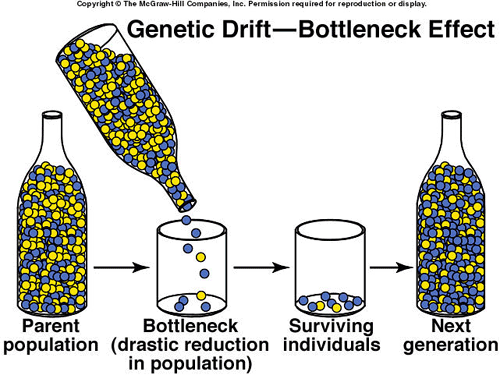The Extinction
Vortex
Tuesday Week 8
Announcements:
News Item: Jared Burch
Field trips - submit 1 page summary/reflection on Moodle for full credit: in week 1 of term go to the assignment description, & at bottom of page is a place to upload a file
Returning mini-exams today; an exam key will be posted on Moodle site soon so you can check your answers
Tuesday - Question of the Day: Who gets hit first by extinction?
Objectives:
Discuss/remember what "background" extinction rates are & have been for life on Earth
Understand what makes species susceptible to extinction
What makes some species rare?
Recognize the hazards of small population sizes & the "extinction vortex"
Begin pondering this moral dilemma: when should we humans become involved in saving rare species, if ever?
Powerpoint - "The Extinction Vortex"
The following notes augment/duplicate the notes in the Powerpoint slides:
Question 1: Explanation
What are "background" extinction rates for various groups of species?
source - http://www.enchantedlearning.com/subjects/dinosaurs/extinction/
Fossil evidence indicates that 2-5 families of marine invertebrates (most abundant fossils) are lost every million years.
Based on fossil record, species longevities range from 1-10 million years.
But what about species that are not well-represented in the fossil record? Many of them must appear and disappear at a much higher rate.
Question 2:
What makes species susceptible to extinction?
Wilson lists several causes of rarity, but all are ultimately linked to small population size.
What are three ways in which a species can be rare?
In your groups, each person adopt one of the bird species Wilson uses to illustrate the "layers" of rarity (p. 228-229):
Bachman's warbler
Kirtland's warbler
Red-cockaded woodpecker
a very common species like the American Robin
Each group member sketch a hypothetical map/diagram illustrating how your bird species might be distributed on the landscape (how wide a range, how abundant within the range(s), how abundant is the necessary habitat or niche)
Do this quickly - take 5 minutes max - & share the results with your group
Discuss how species get to be so rare in the first place
One of you will be asked to report back to the class; you should be able to explain any of the 3 patterns described, and have some ideas about how to respond to the discussion question.
Question 2:
What makes species susceptible to extinction?
Wilson lists several causes of rarity:
specialization (e.g. red-cockaded woodpecker)
very small geographic range (endemic species) (e.g. Kirtland's warbler)
sparse population within range (e.g. Bachman's warbler)
large body size (= small population size)
top predators are always rare, due to the nature of food chains & energy transfer
chance events that isolate a population (&, incidentally, may lead to speciation...)
Question 3:
What are the hazards of small population size?
inbreeding depression
other hazards?
Activity with M&M's
**Is there variation in your population?
**Could evolution occur in this population?
Take a sample of the population - mix the M&M's well, and have 1 member of your team close their eyes and take 10 out of the bag
Is the ratio of colors the same in your sample as it was in the original population?
If you kept re-sampling the population randomly like this, what might happen to the distribution of "fur colors" in the population?
Based on those 10 original individuals, if the population was very successful and began to grow, even if it got as big as the original population, what would the distribution of colors look like?
This is "genetic drift" - the change in genetic make-up of a small population over time, simply as a result of chance and small sample sizes
Question 3:
What are the hazards of small population size?
inbreeding depression
genetic drift (= sampling error)
other hazards?
The previous example shows what can happen to variation in a population when it is small. But how do populations get to be small in the first place? And what impact might that have on genetic diversity?
Scenario 1: A large population of animals is hit by a deadly disease, over 3/4 of the population dies, and survival is not linked to fur color.
What does the surviving population look like, in terms of fur color ratios?
What could happen to the color distribution over time, based on the first set of activities you did above?
This is called the "bottleneck effect"

example: Cheetahs
Scenario 2: A large population of animals is migrating, and a very small group of individuals (1/4 of the total) gets separated from the group and blown off course (birds are a good model group for this exercise) to an island where they establish a new "colony."
What does this founding colony look like, in terms of color ratio?
What could happen to the color ratio over time?
Would this new colony look the same as the original population did, once it had been isolated for several generations?
Has evolution occurred in this example?
Was this evolution by natural selection?
This is called the "founder effect"
similar results as for a bottleneck event
example: birds arriving on Hawaiian Islands
Question 3:
What are the hazards of small population size?
inbreeding depression
genetic drift (= sampling error)
two ways of getting small populations, & thus genetic drift:
bottleneck effect
founder effect
Question 3:
What are the hazards of small population size?
The combination of all of the above factors leads to -
The "Extinction Vortex"

Question 4:
Begin pondering this moral dilemma: when should we humans become involved in saving rare species?